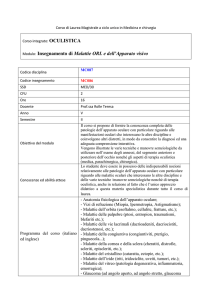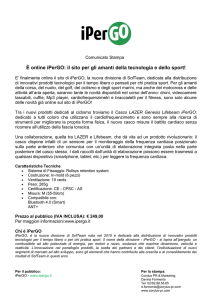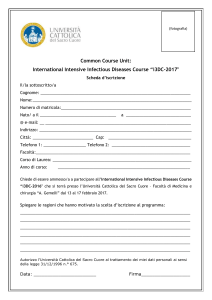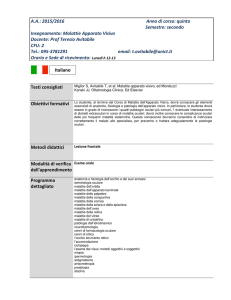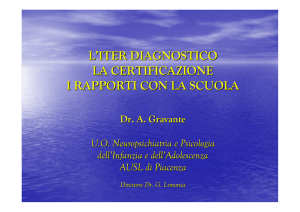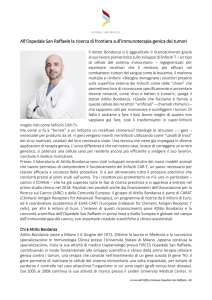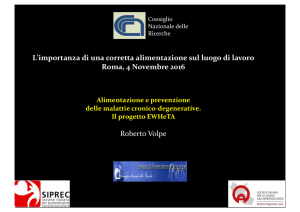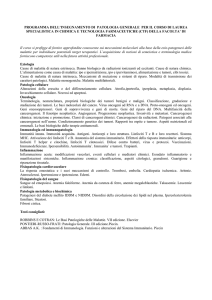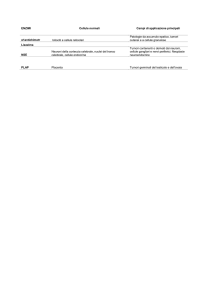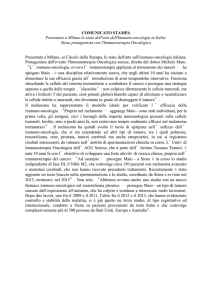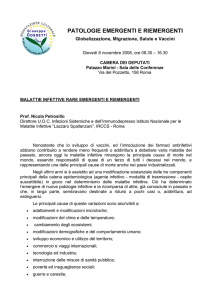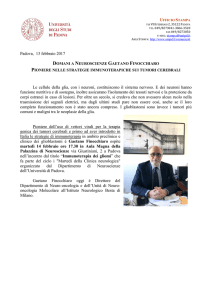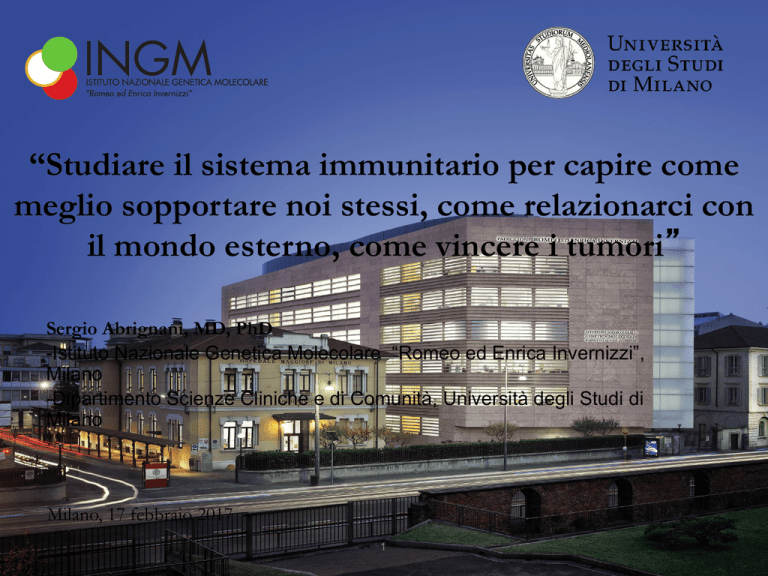
“Studiare il sistema immunitario per capire come
meglio sopportare noi stessi, come relazionarci con
il mondo esterno, come vincere i tumori”
Sergio Abrignani, MD, PhD
- Istituto Nazionale Genetica Molecolare “Romeo ed Enrica Invernizzi”,
Milano
- Dipartimento Scienze Cliniche e di Comunità, Università degli Studi di
Milano
Milano, 17 febbraio 2017
1
Correlazione tra spesa in ricerca e sviluppo (R&S)
e crescita del PIL (dati in USD costanti al 2000)
2
Fonte: elaborazione The European House – Ambrosetti su dati OCSE e IMF, 2015
Alcune voci del PIL italiano (EUR 1642 miliardi)
% del PIL
Miliardi di €
Area
4,7%
77,18 miliardi
Gioco d’azzardo
1,5%
24,63 miliardi
Droghe e prostituzione
1,38%
22,66 miliardi
Ricerca scientifica Pubblica
e Privata
1,0%
16,42 miliardi
Maghi/fattucchiere/
ciarlatani/guaritori
3
Finanziamenti Filantropici alla Ricerca Scientifica
Dati espressi in % del PIL nazionale
0%
1%
2%
USA
UK
Germania
Francia
Italia
1,67%
0,73%
0,22%
0,14%
0,10%
Da: Charities Aid Foundation, briefing paper, 2012
4
3%
Istituto Nazionale Genetica Molecolare – INGM
“Romeo ed Enrica Invernizzi”
The National Institute of Molecular Genetics (INGM) has been established in 2005
as a not-for-profit “translational” research centre. The founding members are:
Italian Ministry of Health: 20 millions EUR
Fondazione “Romeo ed Enrica Invernizzi”: 20 millions EUR
Fondazione IRCCS Ospedale Maggiore Policlinico: The new
Invernizzi building
Lombardy Region
5
Mission
•
Preventive molecular medicine for chronic diseases: INGM carries translational
research projects aimed at elucidating pathogenic mechanisms of diseases. This may
lead to the identification and development of new diagnostics approaches and
therapeutic strategies, addressing secondary prevention of chronic diseases.
Vision
•
Improve the quality of life of patients, while making public health more
sustainable through the research of mechanisms that regulate gene expression and
immune responses.
6
Come si finanzia l’investimento in ricerca non
industriale nel mondo occidentale
SOCI FONDATORI / ISTITUZIONALI
(40 – 60 %) HARD MONEY
FILANTROPIA
Peggiori
Migliori
(media)
Eccezionali
100 %
NAZIONALI
80 %
Soft Money
60 %
40 %
GRANTS
COMPETITIVI
Hard Money
20 %
EUROPEI
INTERNAZIONALI
0%
Time
(non EU)
CONTRATTI
AZIENDE
(40 – 60 %) SOFT MONEY
PROPRIETÀ
INTELLETTUALE
FUND RAISING
OUT LICENSE
SPIN OFF
5 X mille e similari
DONAZIONI
7
Flusso delle attività di ricerca nella creazione e
realizzazione del valore
Ricercatori ad alto
potenziale
Grants competitivi
e Fund raising
Licenze &
Royalties
Ricerca
Impact
Factor
Industria
Pubblicazioni
Brevetti
8
Distribuzione degli investimenti totali in Venture Capital nelle principali
economie mondiali, 2013
9
Fonte: elaborazione Geyser, The European House – Ambrosetti su dati AIFI e altre fonti, 2015
INGM research at a glance
INGM research activity started in 2007 in temporary labs inside the campus of the
IRCCS Ospedale Maggiore Policlinico of Milan. We moved into the new research
centre in October 2013.
In 2016, INGM has reached 100 researchers and more than 70 papers have been
published in the most important scientific journals in the last 5 years, with an
average IF of 7,5 and > 1400 citations. From 2011 to 2016, INGM has obtained more than 19 millions EUR from
competitive grants, both national and international. This includes 3 ERC grants (2
Advanced and 1 Consolidator).
The scientific results obtained by INGM have led to the deposit of 2 international
patents on autoantibodies biomarkers of chronic diseases and 1 patent on new
molecules on tumor infirtrating Tregs which could be new therapeutic targets for
monoclonal antibodies (working on a start up company).
10
Flusso delle attività di ricerca nella creazione e
realizzazione del valore
Ricercatori ad alto
potenziale
Grants competitivi
e Fund raising
Licenze &
Royalties
Ricerca
Impact
Factor
Industria
Pubblicazioni
Brevetti
11
Come si finanzia la ricerca non industriale nel mondo
occidentale
100 %
Peggiori
Migliori
(media)
Eccezionali
80 %
Soft Money
60 %
40 %
20 %
Hard Money
0%
Time
12
INGM Funding: Hard money Vs Soft money
6.000.000,00 €
5.000.000,00 €
4.000.000,00 €
Institutional funding
Grants
TOT. 5.500.000
TOT. 4.960.000
2.300.000
1.800.000
3.000.000,00 €
2.000.000,00 €
3.160.000
3.200.000
2015
2016
1.000.000,00 €
- €
13
Molecular medicine: secondary prevention
1) New knowledge
Biomarkers
2) New molecular leads
Therapeutic targets
14
INGM approach to translational research
Immunology
Clinics
Ability to purify and
characterize in details
primary human
lymphocyte subsets from
liquid and solid organs
Biologic material from
well pedigreed patients
are readily available
INGM
New diagnostics and
therapeutic targets
Functional genomics
Biomolecular and functional analyses
with epigenetic and genomic
approaches
15
INGM research areas
1. Tumors
2. Autoimmune diseases
3. Infectious diseases
Immune mediated
mechanisms of disease
16
Tumors, autoimmune diseases and Infective/inflammatory disorders
Tissue infiltrating lymphocyte subsets – human primary cells purified at homegeneity to assess:
1) Transcriptomics: with de novo identification of coding and non-coding transcripts
2) Translation: translational control of metabolism and transcription
3) Epigenetics: role of repetitive elements and polycomb in lymphocyte functions
4) Immunometabolism: role of purinergic receptors in regulating tissue responses and microbiota
composition in the intestine
5) Biomarkers: autoantibodies
17
INGM aims at becoming in a few years an
internationally recognized research center for
precision medicine specialized in molecular
immunology with particular emphasis on single
cell analysis of human CD4 T-cell subsets and
their role in health and disease
1) Health: Preventive vaccines
2) Diseases: Tumors and immunomediated diseases
18
Il sistema immunitario ci protegge
dalle minacce esterne
(germi, virus…)
…ed interne (tumori…)
19
Punti cardine del Sistema Immunitario
Specificità
+
Memoria
La specificità è data da un numero praticamente infinito di recettori presenti sui
linfociti T e B capaci di riconoscere qualsiasi struttura antigenica. Di questo
riconoscimento specifico rimane memoria come aumento di frequenza delle
cellule che hanno quel recettore.
A seguito del riconoscimento specifico, i linfociti si attivano a svolgere la loro
funzione effettrice secretoria: i linfociti B producono anticorpi, i linfociti T
producono citochine e chemochine
Linfocita B
Anticorpi
Antigeni
Linfocita
Linfocita T
Riconoscimento di uno
specifico antigene
(specificità)
Proliferazione
(memoria)
20
Funzione effettrice
Citochine e chemochine
AMBIENTE
Fattori che agiscono sul
sistema immunitario
STILE DI VITA
GENETICA
21
A balanced Immune System
22
The dramatic effect of some emerging diseases,
yesterday and today
Source: P. Palese. Influenza: old and new threats.
Spanish Flu (1918)
Nature Medicine 10:S82-S87, 2004
AIDS in Africa (now)
Source: World Bank World Development Indicators, 2004
23
1 tumore su 7 è causato da infezioni croniche
Elminti EBV
HTLV-1
Epatite B/ Epatite C
81% del Cancro del fegato
Papilloma virus
89% del Cancro della
Cervice 24
HIV/
HHV-8
Helicobacter pylori
56% del Cancro dello
stomaco
Vaccination Has Been Instrumental in Reducing Infectious
Diseases and Remains the Most Effective of the Successful
Medical Interventions
Drop in death rate for diseases prevented or treated with innovative
medicines (pharmaceuticals) 1965 – 1999:
Infectious Diseases
(polio, measles,
VACCINATION
- >97%
Hib, HVB, Hib etc)
THERAPEUTICS
Rheumatic fever and
rheumatic heart disease
-75%
Hypertensive heart disease
- 67%
Ulcer of stomach and duodenum
- 61%
- 41%
Ischemic heart disease
•
Source: EFPIA 1999 – 2002
25
Impatto della vaccinazione anti-HBV sull’infezione
da HBV a sul tumore del fegato a Taiwan
26
27
Invasive Meningococcal Disease
Rapidly progressive, often fatal disease with significant sequelae for many survivors
• Most cases occur in previously healthy
persons, especially infants and
adolescents
• Cause of significant morbidity
and mortality
• Approximately 10% of cases are fatal
• Approximately10% to 20% of
survivors have significant sequelae
(amputations, deafness,
neurodevelopmental deficits)
1. Rosenstein NE, et al. N Engl J Med. 2001;344:1378-1388; 2. World Health Organization. Meningococcal meningitis factsheet. 2010.
Images in left cluster courtesy of Meningitis Research Foundation UK and are available at www.meningitis.org.
28
Negli anni ‘70 si discuteva di possibili
controindicazioni sull’uso del casco
Infondatezza di presunte controindicazioni sull’uso del casco per i motociclisti
a) Il casco non è efficace al crescere della velocità:
b) Il casco è causa di incidenti per i problemi di visione ed udito che crea al conducente
c) Il casco causa traumi del collo
d) I caschi sono pericolosi perché sono pesanti e poco ventilati
e) Il casco crea un falso senso di sicurezza
Come dimostrato nel fondamentale rapporto Haddon (Haddon, 1980, pagg.IV.19-IV.23) le
obiezioni sollevate contro l’uso del casco non trovano rispondenza nell’evidenza
scientifica.
In definitiva, l’efficacia del casco nel ridurre di circa il 50% mortalità, morbosità e
gravità delle lesioni alla testa, e di conseguenza i costi a queste associati, è largamente e
inequovocabilmente supportata dalla letteratura scientifica.
29
Consigliereste a vostro figlio di andare in
moto senza casco?
30
Consigliereste a nessuno di vivere senza vaccinarsi?
Malattia
N° di casi (anno)
N° di casi nel 2001
Riduzione
%
100%
Vaiolo
48,164 (1905)
0
Poliomielite
21,269 (1952)
0
Difterite
206939 (1921)
Morbillo
894134 (1941)
Rosolia
57686 (1969)
Parotite
152209 (1968)
Pertosse
265269 (1934)
4788
98.20%
H. influenzae
20000(1992)
242
98.79%
Tetano
1560 (1923)
2
96
19
216
26
100%
99.99%
99.99%
99.78%
99.86%
98.44%
31
A balanced Immune System
32
Stimolazione del sistema immunitario
in soggetti sani (vaccini) e malati (immunoterapie)
Individui sani
Immunoterapia
ATTIVA:
Prevenzione primaria
(vaccini per
malattie infettive)
Immunoterapia ATTIVA
(vaccinazioni per malattie
croniche)
Pazienti
Immunoterapie
Immunoterapia PASSIVA
(anticorpi, immunoglobuline
e citochina somministrati
come farmaci)
33
Malattie in cui si utilizzano anticorpi monoclonali
Tumori
• Cellule tumorali
• Neovascolarizzazione
• Linfociti infiltranti tumori
Infezioni
• RSV
• C. difficile
• Spore (antrace)
Malattie autoimmuni
• Anticorpi immunomodulanti
Osteoporosi
• Osteoclasti
Rigetto di trapianti
NPH
•
C5 complemento
Maculopatia degenerativa
• VEGF
Sclerosi Multipla
• VLA-4
Asma
•
IgE/Fcε
Ipercolesterolemia
• PSCK9
Sepsi
•
Endotossina
Dolori intrattabili
• NGF
Antidoto per farmaci anticoagulanti
• Fattore X
34
L’evoluzione delle opzioni terapeutiche per il trattamento
dei tumori:
Immunoterapia la nuova frontiera
35
L’Immunoterapia rappresenta un cambiamento di Paradigma
per il trattamento dei tumori
I più recenti approcci d’immunoterapia
hanno dato risultati sorprendenti
"game-changing results"
nella maggior parte dei tumori umani
36

